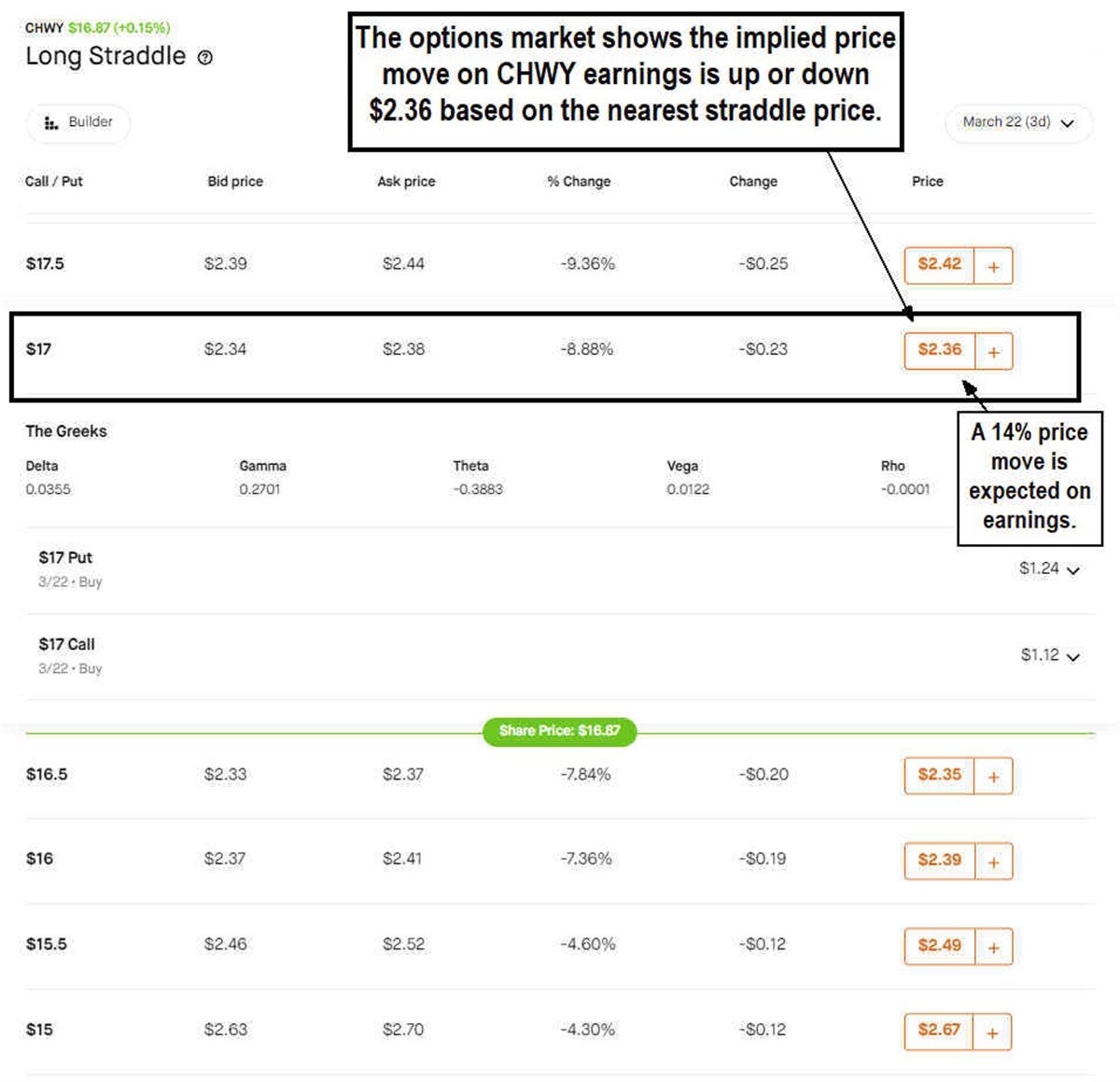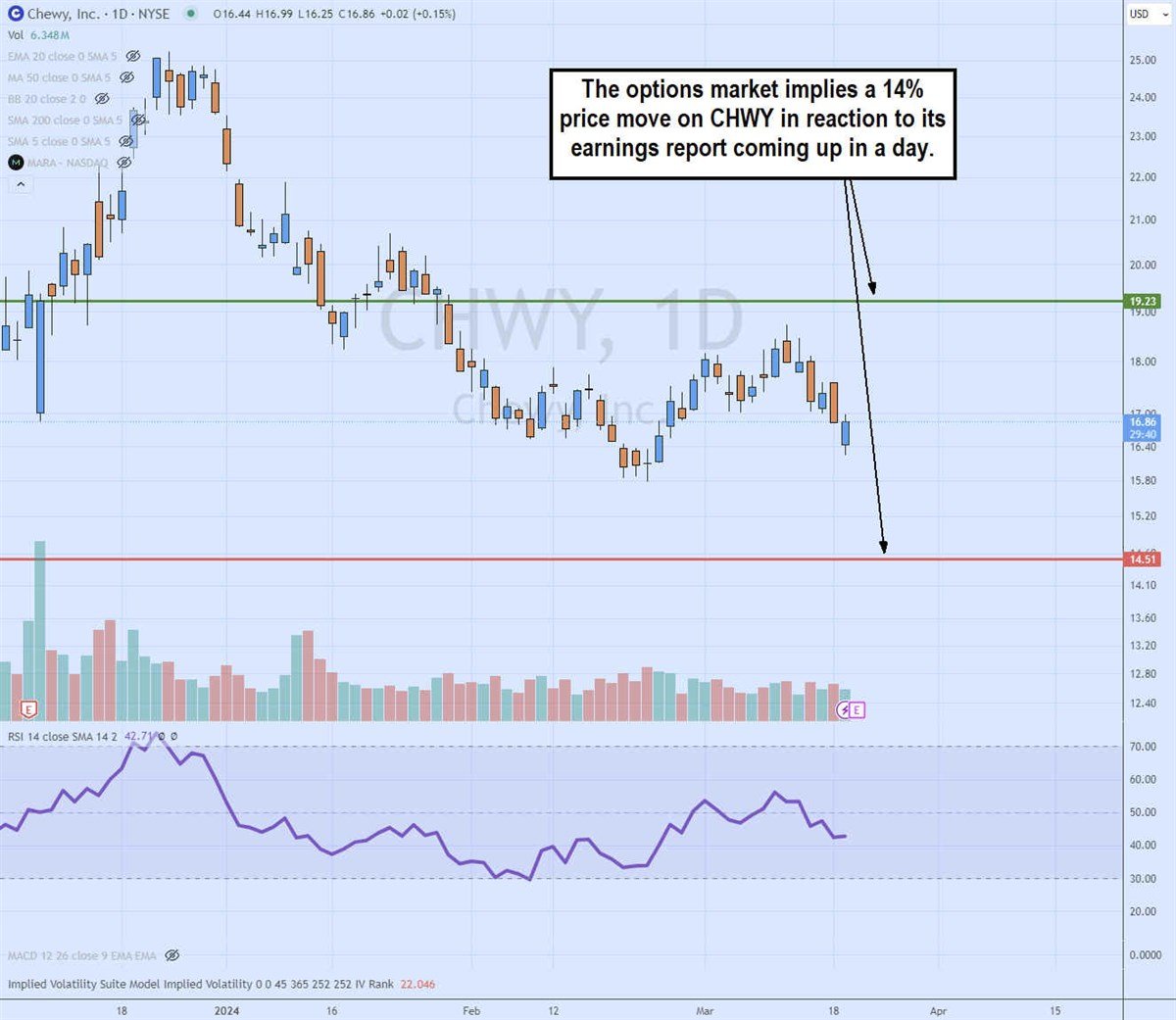
Key points
- Options can be used to calculate the implied price movement of a stock heading towards a catalyst event such as earnings reports, FDA decisions, economic reports and court verdicts.
- Being aware of where the options market expects the price to go can prepare you for the risks and potential opportunities after the catalyst occurs.
- The price of the at-the-money spread helps you gauge how much the underlying security will move in price.
- 5 Stocks We Like Better Than Chewy
Stock options can be used for many purposes, from harvesting income with covered calls and iron condors to taking directional bets or hedging your portfolio. Stock options provide information without even trading it. Stock options can be used to evaluate information about the underlying stock.
While predicting anything in the stock market may be useless, you can hear what the market itself implies about a stock’s potential movement ahead of an event.
What is the implied movement of a stock
The options market can help you evaluate the potential price movement of a stock upon an event such as the release of an earnings report. You’ve probably seen financial TV shows where experts are interviewed about an upcoming earnings report after the close, and the experts say something like, “Well, the options market is pricing in an 8% move in earnings.”
This is not a prediction but rather an indication of how much price movement the market expects. It may or may not come to fruition, but it helps prepare you for the magnitude of the potential movement. The more expensive the at-the-money (ATM) spread, the more volatility you can expect.
When to calculate the implied move
The most suitable time to calculate the implied movement of a stock would be before a catalyst event. This could be a product launch, a court ruling, an FDA decision, or, very often, an earnings report. These are volatility events and the options market will price in volatility. Whenever a catalyst event approaches, you can calculate the implied movement of any optionable stock in any stock sector of the stock market.
How to calculate an implied movement of a stock
To calculate the implied move, you should first find an at-the-money (ATM) straddle as close as possible to the stock’s current price. If your platform does not provide straddle execution of a single trade, you can select the closest strike price, add the call and put option prices to that strike price to derive the straddle value.
The straddle price is how much the options market is pricing in the post-catalyst move. Take the straddle price and divide it by the current price of the underlying stock to get a percentage that the options market is discounting for the catalyst. The equation would be:
(ATM straddle price) divided by (stock price) = +/- implied percentage change
Calculation of an example
Let’s calculate the implicit price increase for the online pet store Chewy Inc. NYSE: WH. Chewy will release its earnings tomorrow after the bell. Chewy’s current price is $16.87. Let’s take the strike price closest to $17 and look at the price of the straddle. You can calculate the straddle price by simply adding the $17 call and put options. The Chew $17 spread is $2.36. Divide the straddle price by Chewy’s current price, which is 14%. The market is pricing in a 14% move in CHWY stock for earnings.

The CHWY candlestick chart illustrates where the market believes CHWY stock will move following the earnings announcement.

With CHWY trading at $16.86, the implied 14% upside price move would be $19.23 and the 14% implied downside price move would be $14.51. An implied price movement of 14% can be considered high volatility. The $17 call has an implied volatility of 223%. This naturally adds more extrinsic value to the option price. Considering that the intrinsic value of the $17 call is zero, the price includes all of the extrinsic value at $1.12. The underlying stock would need to move 14% to break even if the long straddle were to turn into profits.
Use cases for implicit prices
Implied price movements help provide insight into the stock’s potential price range after the catalyst event (IE, earnings report release) occurs. It gives you an idea of the type of volatility expected and prepares you to find potential opportunities. Once you have identified your expected price range, consider the boundaries as potential trading opportunities.
Remember, these are expected price movements and are not always correct. This is not a big secret. You’re not the only one looking at these price ranges. Let’s assume everyone is watching them. Based on this information, you can expect that there will be action around the implied price ranges, so react accordingly; don’t predict.
Before you consider Chewy, you’ll want to hear this.
MarketBeat tracks daily Wall Street’s highest-rated and best-performing research analysts and the stocks they recommend to their clients. MarketBeat identified the five stocks that top analysts are quietly whispering to their clients to buy now before the broader market takes hold… and Chewy wasn’t on the list.
While Chewy currently has a “Moderate Buy” rating among analysts, top analysts believe these five stocks are better buys.
View the five stocks here
As the AI market heats up, investors who have a vision for AI have the potential to see real returns. Learn more about the industry as a whole and the seven companies that are working with the power of AI.
Get this free report